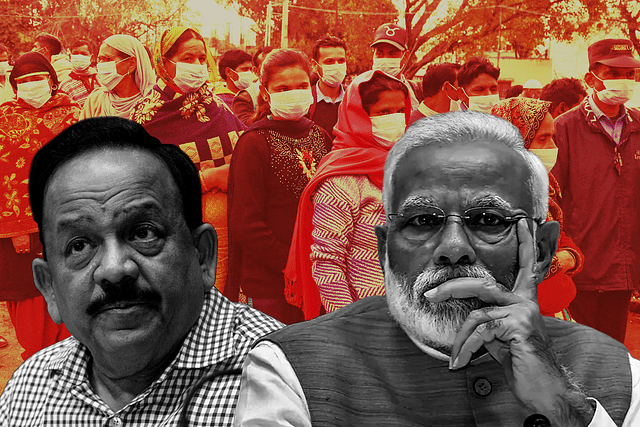
To Counter Anti-Vaccine Propaganda, Government Should Hold Data 101 Lessons For Media Dummies
Why the Modi government needs to be ready to counter propaganda with facts, complete with a Data Lesson 101 for media dummies.
With India’s drive to vaccinate millions of frontline workers now taking off in a slow and steady manner, the government should be proactive in preparing for a lot of adverse publicity based on initial reports of reactions to the jab, including “adverse events”, hospitalisations and occasional deaths.
Given an irresponsible opposition, which would like to see the government trip on Covid’s various banana peels, one has to assume that any information on hospitalisations or deaths will be aired negatively in media. Not least because media is largely data-illiterate.
Consider the data on vaccinations so far: out of the 381,305 vaccinations carried out till the end of 18 January, 580 “adverse events” have been noted, and there have been seven hospitalisations. Two deaths have been observed after vaccination, but none has been linked to the jab itself.
Five hundred and eighty sounds like a high number to get excited about, just as four or five incidents involving churches in 2014 had been hyped up into an “attack on minorities” and “Christians feeling unsafe” in Modi’s India.
In contrast, consider the sheer number of opportunities the media and the opposition will have to drum up concerns over vaccine safety in several states if the government is not seen to be transparent, and is not ready with detailed presentations and explanations on what happened.
For the record, the 580 “adverse events” add up to less than one-sixth of 1 per cent on a vaccination base of 381,305 people. The hospitalisation rate of seven people is insignificant.
In any mass immunisation programme involving millions of people, the absolute number of “adverse events”, hospitalisations and even deaths will be large. But in terms of percentage, these numbers will be minuscule and acceptable, and that is what the government needs to educate the political class and the media on.
A simple example from the demonetisation era will illustrate what one means.
Over 100 people were reported to have died while waiting in bank or ATM queues, either to exchange old notes for new ones, or for depositing the old notes, or for withdrawing money. One mindless writer even called this “financial genocide”.
But here’s what the data says. On any day, 25,000 to 27,000 Indians die for various reasons. In 2016, if we assume a population of 1,250 million, and if we further assume that one person stood in a line for every five-member household, it would mean 50 million people went to banks, ATMs and other places for exchanging old notes or drawing new ones. (Note: The above figures should be taken as approximations based on India’s crude death rate of 7.234 per 1,000 population and 250 million households).
If you do the math, you will note that the 50 million people who went out to stand in queues during those 50-and-odd days of demonetisation should have, even normally, have seen 1,000 people die. The actual deaths in queues may have been in the range of 100-200 people. This is actually to be expected, and barring the odd case of someone who would never have ventured out to a bank due to poor health, the demonetisation “genocide” turns out to be nothing more than normal deaths magnified by a focus on cherry-picked incidents.
During the Indonesian elections of 2019, there were widespread reports that over 500 officials – election officers and policemen – died due to the “sheer exhaustion” of the work. But a BBC reality-check later found that this number was in line with normal death rates in the country because the Indonesian poll involved seven million people, and the daily death rate for such large numbers would be around 137 based on the country’s crude death rate of 7.16 per thousand people. Over four days, the numbers would easily top 500. But that was not how the numbers were played out in the media.
One wonders why BBC and even Indian mainstream media reality checkers fail to adjust adverse events and deaths for population numbers given that crude death rate figures are available easily for all countries from the World Bank.
The Indian government should be ready for adverse propaganda both in Indian media and abroad based on the absolute numbers of adverse events, which will always be high in India’s case. This is what happened when India’s Covid infections started rising above the million mark, when India was actually doing so well compared to more well-equipped healthcare systems in the West. It suits the vested interests to play up the “adverse events” in India’s vaccination drive, for Indian vaccines are the cheapest in the world, and their popularity can undercut profits for Big Pharma in the West.
A few deaths, and the cassandras will be running riot all over TV channels, hyping the numbers in international media. One should compare this with the 29 deaths Norway has reported from the adverse effects of the Pfizer vaccine, the first one to obtain emergency approval in the US and now being used extensively in that country and in Europe.
The Co-WIN app, which is being used to register vaccine recipients, also faced some glitches in the initial days. This is par for the course with any new app. Consider how many updates Android, Windows and other kinds of global software companies saddle you with every week. Co-WIN will be fixed in the coming days, rest assured, but the propaganda will linger.
The Modi government needs to be ready to counter propaganda with facts, complete with a Data Lesson 101 for media dummies.